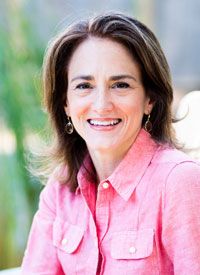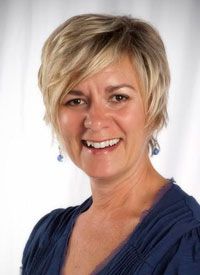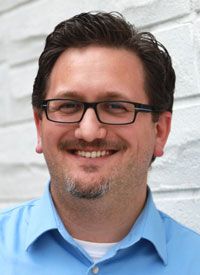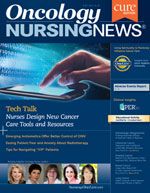Nurse-Designed Software Innovations Are Changing the Cancer Experience
As nurses, we’re skilled at innovating. We have to be. The nature of our work means we often have to find new ways to help our patients. From new teach­ing methods to time-saving wound care tech­niques, every nurse has, at some point in his or her career, needed to think up something on the fly for the benefit of a patient.
As nurses, we’re skilled at innovating. We have to be. The nature of our work means we often have to find new ways to help our patients. From new teach­ing methods to time-saving wound care tech­niques, every nurse has, at some point in his or her career, needed to think up something on the fly for the benefit of a patient.
This is innovation in action, and it's at the heart of the MakerNurse movement. Started in 2013, MakerNurse focuses on identifying and fostering nursing innovation in hospitals across the United States.
Every day, nurses and technology specialists are working to improve cancer outcomes and make both the treatment and quality of life better for oncology patients. These innovators are using technology to develop products and services that guide cancer treatment, educate patients and families, and promote well-being and a positive outlook.
While these individuals come from different educational and professional backgrounds, they are blazing a trail in the treatment of cancer. They embody the spirit of the MakerNurse movement, using creativity to develop techno­logical solutions in the fight against cancer.
Carevive
Carrie Stricker, PhD, RN

Carrie Stricker, PhD, RN
It’s no secret that oncol­ogy care is complicated. Patients face a laby­rinth of personal and financial challenges during their treatment. Treatment teams want to provide the best evi­dence-based care possi­ble, but are challenged by the staggering amount of available information and trouble­some reimbursement systems.
Carevive Systems, a company cofounded by Carrie Stricker, PhD, RN and Madelyn Herzfeld, BSN, RN, was formed in response to the need to provide more support for patients, families, and care teams.
The idea for Carevive started in 2007 after Stricker noticed a striking need for tools to help navigate the complex world of cancer care. With over 20 years of clinical practice and nursing research experience, Stricker had repeatedly witnessed her own patients’ difficulties in nav­igating through the healthcare landscape. She was inspired by the seminal Institute of Medicine 2005 report, Lost in Transition, to help address the reality that patients who weren't receiving active treatment were "left behind" by the system.
In response, Stricker started to develop care plans to serve people transitioning from treat­ment to survivorship, but making these care plans was extremely time consuming and inef­ficient. Eventually, she realized that emerging technology offered the perfect opportunity to streamline the process. In collaboration with Herzfeld, Carevive was formed in 2013 (origi­nally as On Q Health) to help develop care plans for all phases of the cancer experience, based on current research and patient priorities. It’s currently being used in 30 healthcare systems across the country.
Stricker explained that Carevive’s mission is to “provide clinical workflow tools and patient engagement solutions to help cancer centers in providing comprehensive, value-based care to indi­viduals and families with cancer. The goal is to sup­port patients, families, and survivors in navigating their cancer experiences with optimal quality of life, and as active members of the care team.”
To that end, Carevive's cloud-based technol­ogy consumes and analyzes EMR and other clinical data sources, such as tumor registry data, along with patient-reported health data, to support the care team in planning patients' treatment, managing their symptoms, and sup­porting their survivorship needs. The aggregated data gathered in this process also are used to provide insight into the real-world ex­periences of patients with cancer, enabling pre­dictive analytics and to continuously improve outcomes.
Based on the information reported, patients receive a personalized treatment plan for managing their personal symptoms. These patient-specific plans are focused on such areas as pa­tient priorities, diagnostic data, evidence-based cancer treatment pathways, possible side effects, care and outcome goals, eligibility for clinical trials, and other resources.
Clinically, providers can use the reported in­formation to prioritize concerns during patient visits, encouraging better communication and collaboration between the healthcare team and the patient. The healthcare team can also use reported patient information to map out trends in symptoms, side effects, and patient outcomes. With so much of oncology care funding and reimbursement driven by census, statistics regarding patient treatment at various facilities can help drive cancer costs in a more benefi­cial direction for all.
CanSurround
Meg Maley, BSN, RN

Meg Maley, BSN, RN
The diagnosis and treat­ment of cancer might be the most emotionally devastating experience of a person’s life, but it’s not just the patient who is affected. Cancer reaches out, touching the lives of family members, friends, and even co­workers. Just as an evidenced-based treatment plan is essential in the fight against cancer, so, too, is a plan for the care and support of a per­son’s mental and emotional health. That’s where CanSurround comes in.
CanSurround is the brainchild of cofounders Meg Maley, BSN, RN, Jill Teixeira, MSN, RN, and John Brilliant. Both nurses had already worked in oncology for years; they collaborated together to shape an oncology home health­care company, and had both consulted with WellDoc, a technology company that created software for use in a variety of medical special­ties. Both women saw how the mind’s journey through the cancer experience is often—but not always—neglected.
As Maley explained, “we were very interested in the emotional ride … we wanted to pull togeth­er features that were researched-based and put them on a platform whereby people could access them 24/7, confidentially and on their own terms, to help themselves manage the distress they’re feeling and move them toward resilience.”
Thus, the idea for CanSurround was born.
The pilot CanSurround program launched in 2015, and the company is currently working to commercialize with cancer centers across the country. The program is available online and as a mobile app for anyone affected by cancer.
CanSurround estimates that for every 1 person diagnosed with cancer, at least 5 others are affected by the diagnosis. Patients, family, friends, and coworkers can all benefit from the program, which is focused on creating emotion­al well-being and a positive, mindful approach to cancer treatment.
The program takes a personalized approach to building resilience and reducing stress by utilizing tools and resources proven to help develop a more positive mindset. This is done through education and inspiration. Users have access to a wealth of evidence-based clinical information and cancer resources, including educational materials and checklists for differ­ent phases of care.
Features also include an online journal to record positive thoughts, photos and memories, and multimedia experiences like guided imag­ery, focused breathing, and meditation exercises. Through a partnership with Byron Katie, a thought inquiry program has been developed to help people identify and examine negative, stressful thoughts, one thought at a time, to promote a more positive mindset.
Another option invites users of CanSurround to join a group, allowing people to support and comfort each other in a community that understands the cancer experience intimately. Once subscribed, users will receive emails from the CanSurround team every 3 days with specially selected informational articles and messages to educate, inspire, and inform.
Sickweather
Graham Dodge

Graham Dodge
The idea for Sickweather was born when co­founder, CEO, and president Graham Dodge became a parent. He was concerned after discovering that there was no real-time in­formation about the spread of illness where he lived. During this time, another company cofounder was caring for a parent with cancer and was also worried by the lack of information about illnesses in his community.
Both men were inspired to figure out how illnesses could be tracked, so that they and the public could take more informed steps to protect against getting sick. As Dodge noted, “We see this as being something for anyone who is a caretaker for anyone else—whether its parents with young children or anybody caring for someone having chemo. It’s (for) whoever is in the position of caring for somebody else and making decisions for them.”
Although not developed specifically for pa­tients with cancer, Sickweather provides invalu­able information about the occurrence of illness in a person’s surrounding community. Actively avoiding areas where sickness is present is critical in oncology, because cancer and cancer treatment methods can leave a person with a severely weakened immune system.
The knowledge provided by the program can help those affected by cancer and their caregiv­ers limit their exposure to illnesses that can be devastating to already fragile patients.
Sickweather is available online or as a mo­bile app. The program uses preset algorithms to scan social media networks like Facebook and Twitter for illness by using keywords. Data are also collected from crowdsourced inputs.
Currently, the app is tracking reports in En­glish only, but includes all regions around the world where English is the primary language. Once the resources are available, the company hopes to start translating reports from other languages.
When an illness has been identified, the information about the location of the report is entered into a database, which then shows that information on a map—down to street level and in real time. Individuals can also enter illness information into the system independently. The program collects about 6 million separate re­ports every month.
Users can see where sickness outbreaks were occurring and when they are occurring. People
also can receive illness alerts if they subscribe to Sickweather, making it possible for them to consciously avoid those areas where illness is occurring.
Healthcare Innovation in Action
These are just three examples of innovation in action—inspired by healthcare providers and technology professionals working together to create new software products that benefit oncol­ogy patients and others. With these tools, it is now possible to reach more patients and health­care providers. The spirit of the MakerNurse movement is at the heart of each of these inno­vations, making the journey though the cancer experience more positive and less stressful.
Find Out More
MakerNURSE.com A community of inventive nurses creating solutions to improve patient care every day, providing tools, platforms, and training to help MakerNurses create the next genera­tion of health technology.
Carevive.com Provides a range of tools to support oncology practitioners in their efforts to improve patient care and outcomes, including Electronic Patient-Reported Outcomes (e-PRO), Clinical Trial Accrual, Initial Treatment Plans, Dis­tress/Symptom Management Plans, and Survivorship Care Plans.
CanSurround.com Focuses on reducing stress, building resil­ience, and enhancing well-being for individ­uals affected by cancer, with such features as a multimedia journal, mind—body exercises, and a circle of support, all with an eye toward providing individuals with a healing space accessible anytime, anywhere. For a limited time, patients and caregivers are invited to sign up at CanSurround as early partici­pants, free of charge.
Sickweather.com This sickness forecasting and mapping tool can be especially useful to patients with compromised immune systems due to cancer or its treatment, alerting them to the risk of contagious illness in their area. The program is free; anyone can join, anytime, to start tracking illnesses in their area.

Innovative Program Reduces Nurse Turnover and Fosters Development
Published: September 12th 2024 | Updated: September 12th 2024The US Oncology Network (The Network) has developed one of the most comprehensive programs in the nation to support the professional development and retention of new oncology nurses.


